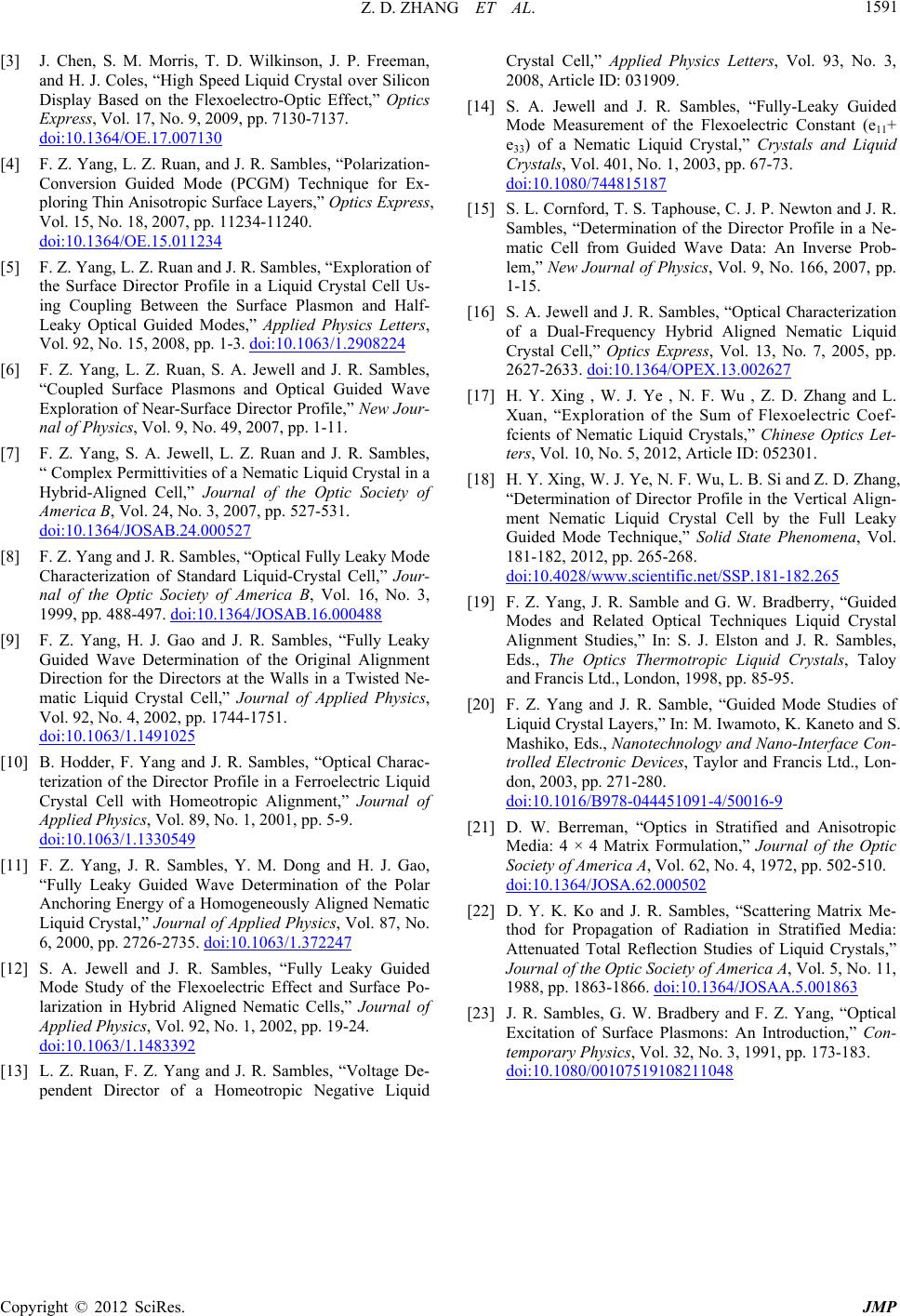
Z. D. ZHANG ET AL. 1591
[3] J. Chen, S. M. Morris, T. D. Wilkinson, J. P. Freeman,
and H. J. Coles, “High Speed Liquid Crystal over Silicon
Display Based on the Flexoelectro-Optic Effect,” Optics
Express, Vol. 17, No. 9, 2009, pp. 7130-7137.
doi:10.1364/OE.17.007130
[4] F. Z. Yang, L. Z. Ruan, and J. R. Sambles, “Polarization-
Conversion Guided Mode (PCGM) Technique for Ex-
ploring Thin Anisotropic Surface Layers,” Optics Express,
Vol. 15, No. 18, 2007, pp. 11234-11240.
doi:10.1364/OE.15.011234
[5] F. Z. Yang, L. Z. Ruan and J. R. Sambles, “Exploration of
the Surface Director Profile in a Liquid Crystal Cell Us-
ing Coupling Between the Surface Plasmon and Half-
Leaky Optical Guided Modes,” Applied Physics Letters,
Vol. 92, No. 15, 2008, pp. 1-3. doi:10.1063/1.2908224
[6] F. Z. Yang, L. Z. Ruan, S. A. Jewell and J. R. Sambles,
“Coupled Surface Plasmons and Optical Guided Wave
Exploration of Near-Surface Director Profile,” New Jour-
nal of Physics, Vol. 9, No. 49, 2007, pp. 1-11.
[7] F. Z. Yang, S. A. Jewell, L. Z. Ruan and J. R. Sambles,
“ Complex Permittivities of a Nematic Liquid Crystal in a
Hybrid-Aligned Cell,” Journal of the Optic Society of
America B, Vol. 24, No. 3, 2007, pp. 527-531.
doi:10.1364/JOSAB.24.000527
[8] F. Z. Yang and J. R. Sambles, “Optical Fully Leaky Mode
Characterization of Standard Liquid-Crystal Cell,” Jour-
nal of the Optic Society of America B, Vol. 16, No. 3,
1999, pp. 488-497. doi:10.1364/JOSAB.16.000488
[9] F. Z. Yang, H. J. Gao and J. R. Sambles, “Fully Leaky
Guided Wave Determination of the Original Alignment
Direction for the Directors at the Walls in a Twisted Ne-
matic Liquid Crystal Cell,” Journal of Applied Physics,
Vol. 92, No. 4, 2002, pp. 1744-1751.
doi:10.1063/1.1491025
[10] B. Hodder, F. Yang and J. R. Sambles, “Optical Charac-
terization of the Director Profile in a Ferroelectric Liquid
Crystal Cell with Homeotropic Alignment,” Journal of
Applied Physics, Vol. 89, No. 1, 2001, pp. 5-9.
doi:10.1063/1.1330549
[11] F. Z. Yang, J. R. Sambles, Y. M. Dong and H. J. Gao,
“Fully Leaky Guided Wave Determination of the Polar
Anchoring Energy of a Homogeneously Aligned Nematic
Liquid Crystal,” Journal of Applied Physics, Vol. 87, No.
6, 2000, pp. 2726-2735. doi:10.1063/1.372247
[12] S. A. Jewell and J. R. Sambles, “Fully Leaky Guided
Mode Study of the Flexoelectric Effect and Surface Po-
larization in Hybrid Aligned Nematic Cells,” Journal of
Applied Physics, Vol. 92, No. 1, 2002, pp. 19-24.
doi:10.1063/1.1483392
[13] L. Z. Ruan, F. Z. Yang and J. R. Sambles, “Voltage De-
pendent Director of a Homeotropic Negative Liquid
Crystal Cell,” Applied Physics Letters, Vol. 93, No. 3,
2008, Article ID: 031909.
[14] S. A. Jewell and J. R. Sambles, “Fully-Leaky Guided
Mode Measurement of the Flexoelectric Constant (e11+
e33) of a Nematic Liquid Crystal,” Crystals and Liquid
Crystals, Vol. 401, No. 1, 2003, pp. 67-73.
doi:10.1080/744815187
[15] S. L. Cornford, T. S. Taphouse, C. J. P. Newton and J. R.
Sambles, “Determination of the Director Profile in a Ne-
matic Cell from Guided Wave Data: An Inverse Prob-
lem,” New Journal of Physics, Vol. 9, No. 166, 2007, pp.
1-15.
[16] S. A. Jewell and J. R. Sambles, “Optical Characterization
of a Dual-Frequency Hybrid Aligned Nematic Liquid
Crystal Cell,” Optics Express, Vol. 13, No. 7, 2005, pp.
2627-2633. doi:10.1364/OPEX.13.002627
[17] H. Y. Xing , W. J. Ye , N. F. Wu , Z. D. Zhang and L.
Xuan, “Exploration of the Sum of Flexoelectric Coef-
fcients of Nematic Liquid Crystals,” Chinese Optics Let-
ters, Vol. 10, No. 5, 2012, Article ID: 052301.
[18] H. Y. Xing, W. J. Ye, N. F. Wu, L. B. Si and Z. D. Zhang,
“Determination of Director Profile in the Vertical Align-
ment Nematic Liquid Crystal Cell by the Full Leaky
Guided Mode Technique,” Solid State Phenomena, Vol.
181-182, 2012, pp. 265-268.
doi:10.4028/www.scientific.net/SSP.181-182.265
[19] F. Z. Yang, J. R. Samble and G. W. Bradberry, “Guided
Modes and Related Optical Techniques Liquid Crystal
Alignment Studies,” In: S. J. Elston and J. R. Sambles,
Eds., The Optics Thermotropic Liquid Crystals, Taloy
and Francis Ltd., London, 1998, pp. 85-95.
[20] F. Z. Yang and J. R. Samble, “Guided Mode Studies of
Liquid Crystal Layers,” In: M. Iwamoto, K. Kaneto and S.
Mashiko, Eds., Nanotechnology and Nano-Interface Con-
trolled Electronic Devices, Taylor and Francis Ltd., Lon-
don, 2003, pp. 271-280.
doi:10.1016/B978-044451091-4/50016-9
[21] D. W. Berreman, “Optics in Stratified and Anisotropic
Media: 4 × 4 Matrix Formulation,” Journal of the Optic
Society of America A, Vol. 62, No. 4, 1972, pp. 502-510.
doi:10.1364/JOSA.62.000502
[22] D. Y. K. Ko and J. R. Sambles, “Scattering Matrix Me-
thod for Propagation of Radiation in Stratified Media:
Attenuated Total Reflection Studies of Liquid Crystals,”
Journal of the Optic Society of America A, Vol. 5, No. 11,
1988, pp. 1863-1866. doi:10.1364/JOSAA.5.001863
[23] J. R. Sambles, G. W. Bradbery and F. Z. Yang, “Optical
Excitation of Surface Plasmons: An Introduction,” Con-
temporary Physics, Vol. 32, No. 3, 1991, pp. 173-183.
doi:10.1080/00107519108211048
Copyright © 2012 SciRes. JMP